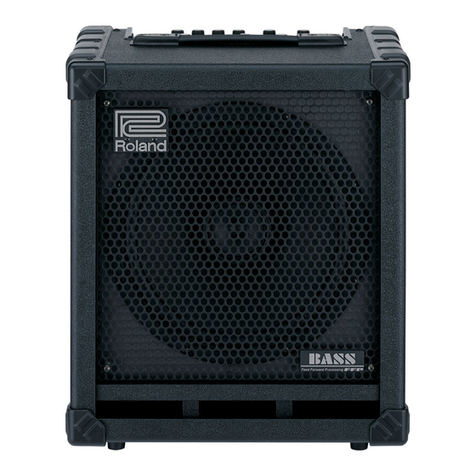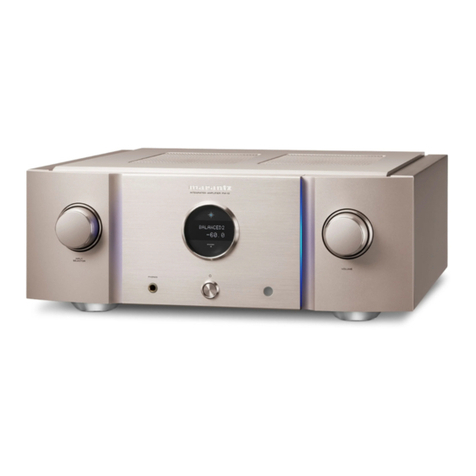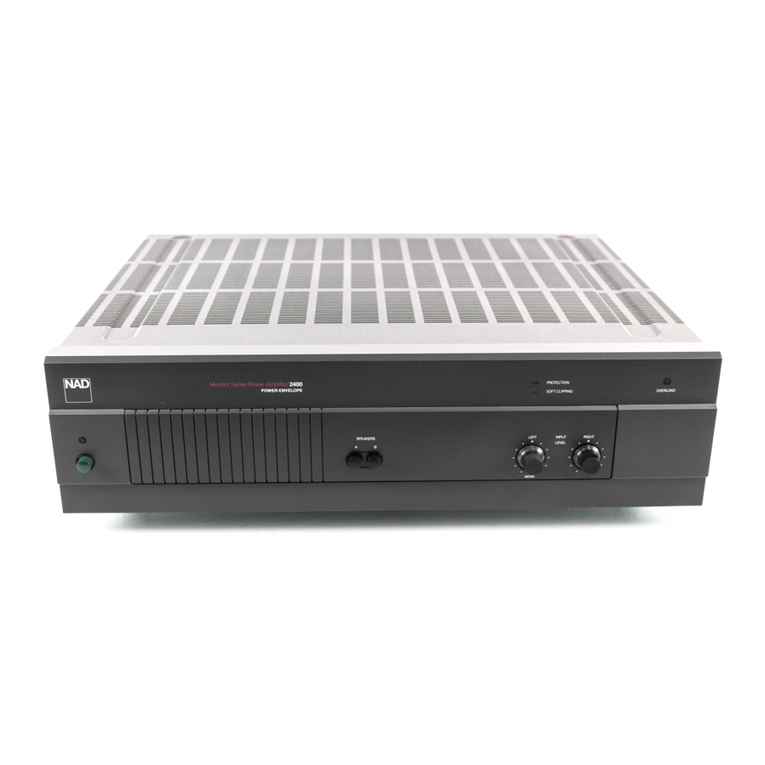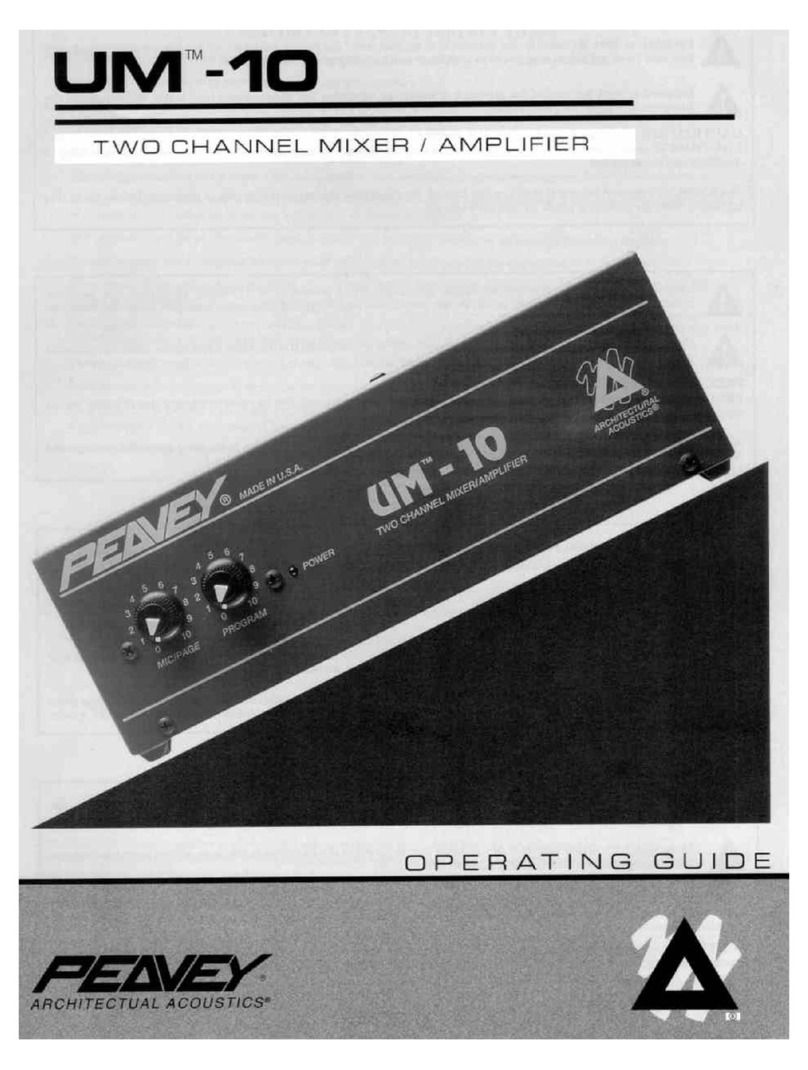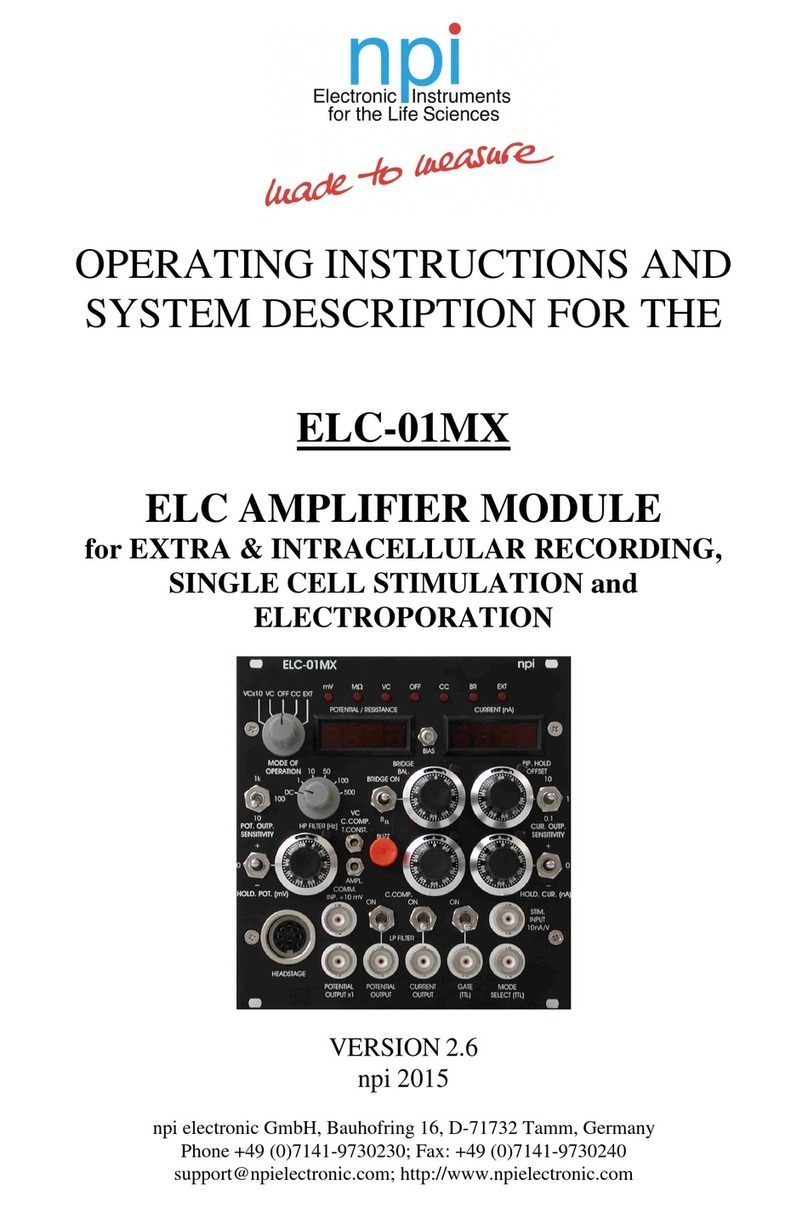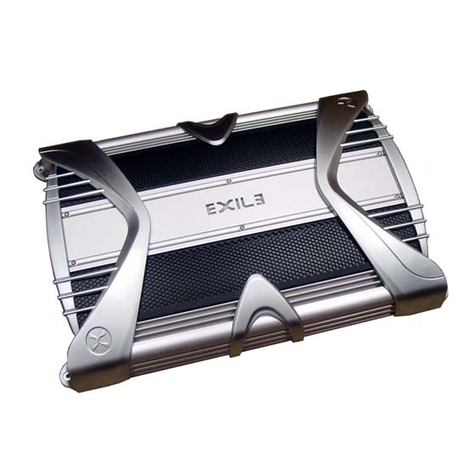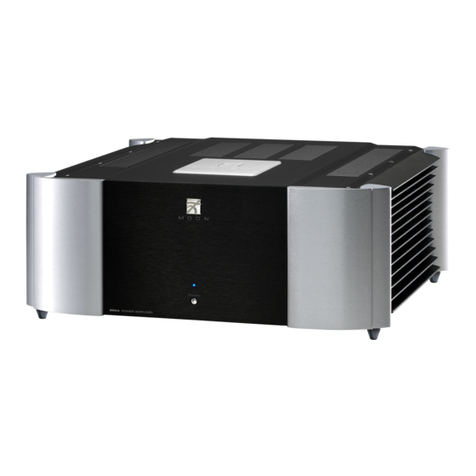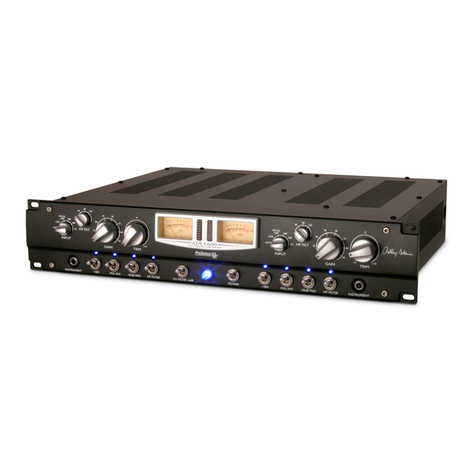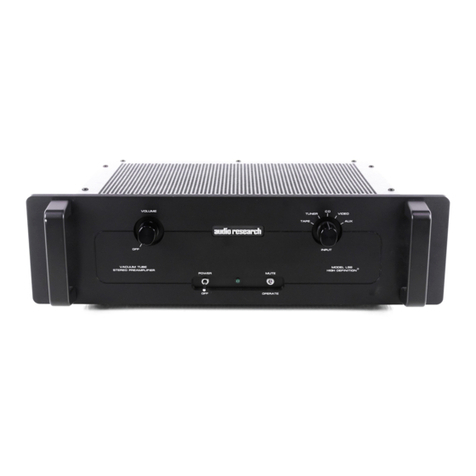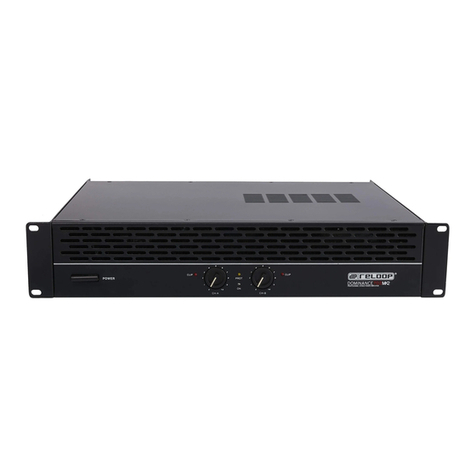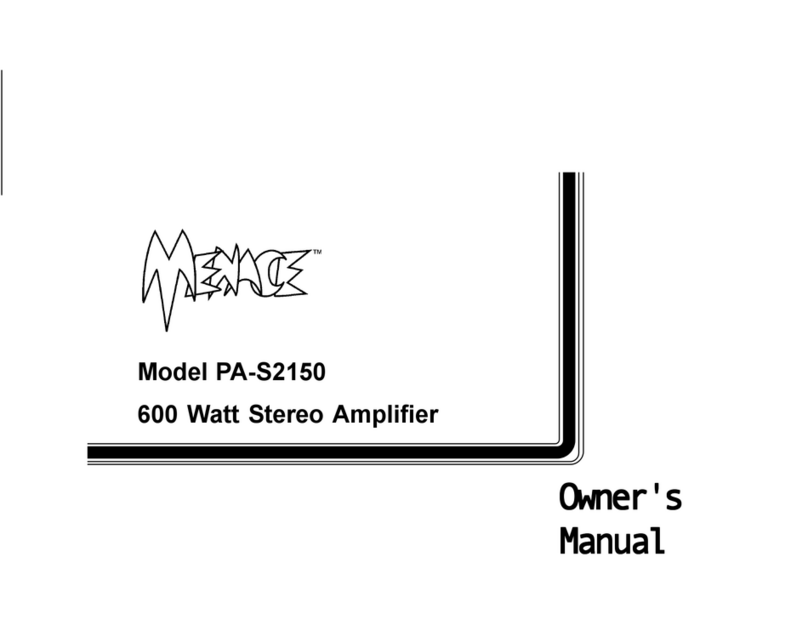Tellabs 4001C User manual

il!itellabs
technical manual
76-844001C
rev A
practice section
844001C
©Tellabs, Inc., 1August 1986
all rights reserved, printed in USA
4001C
Prescription Line Amplifier
1.
general
description
1.01 The 4001CPrescription
Line
Amplifier mod-
ule (figure
1)
provides active prescription level con-
trol, active prescription
amplitude
equalization,
and
impedance
matching
for
the transmit
and
receive
channels
of
a
4wire
voice-frequency
transmission
facility. The
4001C
also
contains
two
independent
sealing-current sources,
one
on the
facility
side
and
the
other
on
the
terminal
side
of
the
module.
Note:
Because
the
4001C
has
identical
equalizers
in
both
channels,
identical
impedance-matching
capabilities
at
all
four
ports,
and
identical
sealing-
current
sources
on
the
facility
and
terminal
sides, it
can
be
used
either
at
an
intermediate
point
or
near
an
end
point
of
a
4wire
facility.
Although
the
terms
"facility
side"
and
"terminal
side"
do
not
strictly
apply
in
intermediate
applications, these terms will,
for
convenience,
be
used
throughout
this
practice
as follows:
Facility
side
will
refer
to
the
receive
input,
transmit-output
side
of
the
4001C,
and
ter-
minal
side
will
refer
to the transmit-input, receive-
output
side
as
shown
on
the
block
diagram
in
section
5
of
this practice.
1.02 This practice
section
is reissued
to
cover
the
Issue 4version
of
the
4001C
module
(Tellabs
part
number
844001
C).
The
Issue 4
module
is identical
to its Issue 3
predecessor
except
for
the
addition
of
afront-panel power-on
indicator
LED.
1.03 The 4001C's
transmit
and
receive amplifiers
can be
independently
prescription-set
to
provide
from 0to
24dB
of
loss
or
0to
24dB
of gain in
their
respective channels. For
each
channel, gain
or
loss
is
selected
via afront-panel slide switch. The de-
sired
amount
of
gain
or
loss is
then
introduced
into
each channel in precise
0.1
dB
increments
via a
front-panel DIP switch. The maximum
output
level
of
each channel is
+10dBm,
with
distortion
at max-
imum
output
less than 1percent.
1.04 All
four
ports
of
the
4001C
module
can be
switch-optioned
for
balanced 1200, 600,
or
150-
ohm
terminating
impedance. The
impedance
of
the
two
facility-side
ports
is
selected
independently
from
that
of
the
two
terminal-side ports. The trans-
formers
at
all
four
ports
of the
module
are center-
tapped
to
derive balanced simplex leads.
•
•
contents
section
1
general
description
section
2
application
section
3
installation
section
4
circuit
description
section
5
block
diagram
section
6
specifications
section
7
testing
and
troubleshooting
page
1
page
2
page
4
page
8
page
10
page
9
page
11
figure
1.
400
1C
Prescription Line
Amplifier
1.05
In
addition to active prescription level-control
circuitry, the 4001Ccontains active prescription
slope-type
amplitude-equalization
circuitry
in both
channels. The
transmit
and receive equalizers are
identical,
each
providing from 0
to
7.5dB of gain
at
2804Hz
(re 1004Hz). Equalization is
introduced
into
each
channel
independently, in 0.5dB increments,
via DIP
switches
on
the
module's
front panel.
1.06 The
4001C
can be
optioned
to
provide
25mA
of internally
generated
sealing current
to
metallic facilities on the
facility
and terminal sides
of
the
module,
to
accept
externally
generated
seal-
ing
current
from the
far
ends
of the facilities on both
sides
of
the
module,
to
derive normal simplex leads
on
both
sides of the module,
or
to provide bypassed
(straight-through) simplex-lead signaling via apath
separate from
the
transmit and receive transmission
paths. Each of
the
4001C's
two
internal sealing-
current
sources
has a"ZAP" feature by which a
greater
amount
of sealing
current
is provided
for
a
few
seconds
when
power
is initially applied to the
module.
1.07 The
front
panel of the
4001C
is designed so
that
all level and equalization
adjustments
can be
made
while
the
module
is
mounted
in place. Six
front-panel
bantam-type
test
jacks
facilitate align-
ment
and
maintenance. Both bridging and opening
jacks
are provided at
the
facility-side ports; opening
jacks
alone are provided
at
the terminal side ports.
Front-panel
seal
curr
1and
seal
curr
2LED's light
when
the
module's
internal facility-side and ter-
minal-side sealing-current options, respectively, are
activated and sealing
current
is flowing. Also
located on the front-panel is a
pwr
on LED that
lights when
power
is applied
to
the
module.
page
1

practice
section
844001C
1.08 An internally regulated
power
supply
per-
mits
the
module
to
operate
on filtered, ground-
referenced
-22
to
-56Vdc
input.
If
the
internal-
sealing
current
option
is
selected,
input
power
must
be
from
-
42
to
-
56Vdc.
Maximum
current
requirements (at -
48Vdc
input) are as follows:
•With both
sealing-current
sources
inactive,
30mA
at
idle and
65mA
at
maximum transmit and
receive
output
levels.
•With
one
sealing-current source active,
57mA
at
idle and
92mA
at
maximum
output
levels.
•With both sealing-current
sources
active,
84mA
at idle and
132mA
at maximum
output
levels.
1.09 Surge
protection
is provided
for
the
input
and
output
of the
transmit
and receive amplifiers.
Reverse-battery
protection
and
transient limiting
are provided
for
the
module's
internal
power-supply
circuitry.
1.10 AType 10 module,
the4001C
mounts
in
one
position
of
aTellabs Type 10
Mounting
Shelf, ver-
sions
of
which
are available
for
relay-rack
or
appa-
ratus-case installation.
In
relay-rack applications, up
to 12
modules
can be
mounted
across
a19-inch
rack, while up
to
14
modules
can be
mounted
across a
23-inch
rack. The
4001C
can also be used
in
the
Tellabs
246
Resistive Data
Bridge
System, in
which case
the
module
mounts
in
one
position
of
the
Tellabs
246
Mounting
Assembly. The
246
Assembly, basically aprewired Type 10
Shelf
equipped
with a
connectorized
printed-circuit back-
plane,
houses
up
to
12
modules
and
mounts
in a
19-inch relay rack. The
246
Assembly
and
all rack-
configured
Type 10 Shelves each
occupy
6
inches
of
vertical rack space.
2.02
Because
equalization
is available in both
channels
(instead
of
in
the
receive
channel
only),
the
4001C
can
be used not
only
as aterminal
repeater
but
also as an
intermediate
repeater.
Figure 2
shows
atypical off-premises-station (OPS)
circuit
in which
the
4001C
is used in avariety
of
applications.
2.03 The
4001C
can
also be used in
the
Tellabs
246
Resistive Data
Bridge
System,
where
each
module
provides an
active
interface
between
an
external
4wire
facility
and
the
passive fixed-loss
data
bridge. Figure 3
shows
atypical
configuration
for
two
4wire
6way
fixed-loss
data
bridges.
level
control
2.04 Prescription level-control
circuitry
allows
from 0
to
24dB
of
gain
or
loss
to
be
introduced
into
each
channel
of
the
4001C
independently.
For
each channel,
either
flat gain
or
flat loss
is
selected
via afront-panel
slide
switch. The precise
amount
of
gain
or
loss
required
in
the
channel
is
then
selected
in
0.1
dB
increments, via an eight-position
front-panel DIP switch.
amplitude
equalization
2.05 The 4001C's
active
slope-type
amplitude
equalizers
allow
from 0
to
7.5dB
of
prescription-set
gain
at
2804Hz
(re 1004Hz)
to
be introduced into
the
module's
receive and
transmit
channels
indivi-
dually.
Adjustable
in
0.5dB
increments
via front-
panel DIP switches,
this
type
of
equalization is
ideal
for
nonloaded
cable
and can also be used
effectively
in
many
loaded-cable
applications
to
compensate
for
the
frequency-response
charac-
teristics
of
metallic
facilities
interfacing
the
module.
2.
application
2.01 The
4001C
Prescription
Line
Amplifier
with
sealing
current
is
designed
for
use
on
4wire
voice-
frequency
transmission
facilities,
where
it provides
active
prescription
level control,
active
prescription
amplitude
equalization,
and
impedance
matching
in
both
the
transmit
and receive channels. The
module
also
contributes
longitudinal
isolation and
surge
protection
for
the
facility. In itself,
the
4001C
module
is
equivalent
to a
4wire-to-4wire
(44V4)
voice-frequency repeater. When used with aTellabs
420X
Terminating
Set
(or
equivalent), a
2wire-to-
4wire
(24V4)
repeater
results.
common
multiple
common
mUltiple~
port/
ports
~portr
ports
"-
I~I~'~IJ~
uuuuu u u
.....
.....
.....
.....
.....
.....
.....
o
000
0000 0 0 00
0 0 0 0 0 0000 0 00
~
~
~
~ ~
~ ~
~~
~ ~
~
figure
3.
Module
arrangement
for
two
4wire 6way resistive
data
bridges
in aTellabs
246
Mounting
Assembly
x
"'
"'-
--
B
TERM
SET
420(X)
4001C
6101/
6104
,---
CO
3
4001C
600
ohm
termination
600
ohm
termination
12~:::
::nati:
_r____
~
<:.
,
intermediate
application
:\
I
j-y
i-
·I~
• • •
••
1
!-
LINE
CXA
~"""""'I'l
CXA
LINE
LINE
t1
f·-
LINE
SF SIG
AMP AMP
AMP
f-
AMP
(FLAI
-
V-f
1.
••
loaded
cable
•
.J
CO 1
1200
ohm
termination
600
ohm
~nation
\
TERM
SF
SIG
LINE
SET
I
FSAI
AMP
420(XI
6101/
4001C
400lC
6103
figure
2.
Typical off-premises-station (OPS)
circuit
using
400
1C Line Amplifiers
page
2

practice
section
844001C
10
figure
4.
Typical
transmit
and
receive
equalizer
response
curves
2.06
Whether
one
or
both
channels'
equalizers
are used
depends
upon
the
4001C's
position
in
the
circuit. Use of
the
module
as
an
amplifier
at
an
intermediate
point
in a
4wire
circuit,
for
example,
Note:
Because
introduction
of
equalization
into
either
channel
of
the 4001C
does
not
affect
1004Hz levels,
equalization
can
be
introduced
not
only
before
but
after
transmission
levels are set.
table
2.
Terminating
impedance
selection
guidelines
often
requires
the
use
of
the
transmit
equalizer
as
well as
the
receive equalizer. In
any
case, equaliz-
ing
at
the
receive
end
of a
circuit
(post-equaliza-
tion) is
generally
preferable
to
equalizing
at
the
transmit
end
(pre-equalization). Pre-equalization
tends
to
amplify
high-frequency
signals
to
alevel
that
is
conducive
to
crosstalk. Post-equalization
not
only
eliminates
this
problem
but
also
expedites
the
equalization
process
because
the
circuit
is
easier
to
equalize
at
the
receive end.
In
some
applications, however,
pre-equalization
may be
necessary
because
post-equalization
at
the
re-
ceive
end
is unavailable.
impedance
matching
2.07
Impedance-matching
transformers
at
all
four
ports
of
the
4001C
can
be
switch-optioned
for
balanced
1200,
600,
or
150-ohm
terminating
im-
pedance. A
single
option
switch
selects
the
desired
impedance
for
both
facility-side
ports
(receive
input
and
transmit
output); a
second
option
switch
per-
forms
this
function
for
both
terminal-side
ports
(receive
output
and
transmit
input). Thus, on
both
the
facility
and
terminal
sides,
the
4001C
can
inter-
face
a
variety
of
facilities
and
equipment,
as listed
in
table
2. The 150-ohm
options
provide asmall
amount
of
slope
equalization
for
long
sections
of
nonloaded
cable
through
the
deliberate
impe-
dance
mismatch.
impedance
facility
or
equipment
interfaced
1200
ohms loaded cable
----
600
ohms nonloaded cable, carrier, SF and
DX
signaling units, terminating sets,
station apparatus
----_.
._-------_._.
------
150 ohms small amount of slope-type amplitude
equalization for long sections of non-
loaded cable through the deliberate
impedance mismatch
I
rr
~
~~
<t,
q.
<t,
//
/5.0
SETTING
7.5
SETTING
"d-<t,
"d><t,
g/ /
/
~/'
:
__
-'-
2.5
SETTING
0.0
SETTING
r
~
\.
FREQUENCY
(Hz)
The equalized gain
response
of each
module
is
not
affected
by
flat gain
or
loss adjustments,
which
are
used
to
provide
precise
transmission
alignment.
The
frequency
response
of the
equalizers
is
shown
graphically in figure 4and
in
tabular format in table
1.
It
8
61
iD
~4
~
..
'-'
2
~
I
0
-2
-4
t
'"
'i
'b
'"
'b
It
receive
equalizer equalized gain (dB)
introduced
at
various frequencies
switch
setting(dB)
300Hz
400Hz
500Hz
800Hz
1004Hz
1500Hz
1800Hz
2500Hz
2804Hz
a0.0 0.0 0.0 0.0 0.0 0.0 0.0
0.0
0.0
0.5 -0.23
-0.19
-0.15 -0.06
0.0
+0.15 +0.24 +0.43
+0.50
1.0
-0.52
-0.42
-0.33 -0.13
0.0
+0.32
+0.52 +0.93
+1.07
1.5
-0.75
-0.60 -0.49 -0.18
0.0
+0.46
+0.74
+1.33
+1.54
2.0
-1.00
-0.80 -0.64 -0.24
0.0 +0.61
+0.98 +1.76 +2.04
2.5
-1.22 -0.98
-0.78 -0.29
0.0
+0.75
+1.20
+2.15 +2.49
3.0 --1.50
-1.20
-0.95
-0.36
0.0
+0.90 +1.45 +2.60
+3.01
35
-1.71
-1.37
-1.09
-0.41
0.0
+1.03 +1.65 +2.97 +3.45
4.0
-2.02
-1.63
-1.29
-0.49
0.0 +1.22
+1.95 +3.54
+4.12
4.5
-2.25
-1.79
-1.42
-0.53
0.0
+1.33 +2.14
+3.90
+4.56
50
-2.49
-1.98
-1.57
-0.59
0.0 +1.47
+2.36
+4.32
+5.08
5.5
-2.68 -2.14
-1.69
-0.63
0.0
+1.58
+2.53
+4.67 +5.51
6.0 -2.89
-2.30
-1.81
-0.68
0.0
+1.69
+2.72
+5.05 +5.99
65
-3.07
-2.44
--1.93
-0.72
0.0
+1.79
+2.87
+5.38
+6.41
7.0
-3.29
-2.61
-2.05
--0.76
0.0
+1.89
+3.05
+5.76
+6.90
7.5 -3.45
-2.74
-2.15
-0.78
0.0
+1.98 +3.19
+6.06
+7.30
table
1.
Typical
transmit
and
receive
equalization
frequency
response
page
3

practice
section
844001C
sealing
current
and
simplex
leads
2.08
The
4001C
contains
two
separate
and in-
dependent
25mA
sealing-current
sources,
one
on
the
facility
side
and
one
on
the
terminal
side
of
the
module.
In
addition, all
four
impedance-matching
transformers
on
the
4001C
are
center-tapped
to
derive
balanced
simplex
(SX) leads.
Option
switches
on
the
facility
and
terminal
sides
of
the
module
afford
a
choice
of
four
sealing-current
and
simplex-lead
options, as follows:
•
When
the
4001C's
internal
sealing-current
op-
tion on
the
facility
side
is
selected,
25mA
of
seal-
ing
current
flows
from
the
transmit
output
port
(pins
41
and
47)
and
returns
via
the
receive
input
port
(pins 7
and
13).
When
the
4001C's
internal
sealing-current
option
on
the
terminal
side
is selected,
25mA
of
sealing
current
flows
from
the
transmit
input
port
(pins
55
and
49) and
returns
via
the
receive
output
port
(pins 5
and
15).
Both
sealing-current
sources
have
aZAP
feature
that
provides
a
greater
amount
of
cur-
rent
for
a
few
seconds
when
power
is
initially
applied
to
the
module. Each
of
the
two
front-
panel
seal
curr
LEOs
lights
when
its
respective
source
is
active
and
current
is floWing.
• A
second
sealing-current/simplex-Iead
option
available
independently
on
the
facility
and ter-
minal
sides
of
the
4001C
excludes
the
module's
sealing-current
sources
from
the
circuit
and
pro-
vides return
paths
for
sealing
current
applied
at
the
distant
end
of
the
facilities.
• A third
option
is
the
derivation
of
normal
simplex
leads on
either
or
both
sides
of
the
module. This
allows
the
4001C
to
be
used
on
circuits
employ-
ing
OX,
loopback,
or
other
de
signaling
schemes
(see
figure
5).
Normal
simplex
leads
can
also
be
used
to
apply
sealing
current
to
a
metallic
facility
from alocal
source
external
to
the
module.
•The
fourth
sealing-current/simplex-Iead
option
is
bypassed
simplex-lead
signaling. This
option
provides
a
straight-through
simplex-lead
signal-
ing path
between
the
module's
facility
and
ter-
minal
sides
that
is
completely
separate
from
the
module's
transmit
and
receive
transmission
paths. A
switch
option
available
when
bypassed
simplex-lead
signaling
is
selected
provides
either
a
normal
straight-through
signaling
path
(RCV IN SX
to
RCV
OUT
SX and XMT IN SX
to
XMT
OUT
SX)
or
areversed
straight-through
signaling
path (RCV IN SX
to
XMT IN SX and
RCV
OUT
SX
to
XMT
OUT
SX).
The reversed
signaling-path
option
is
used
to
compensate
for
polarity
reversals in duplex- (DX-)
signaling
and
ground-start
applications.
3.
installation
inspection
3.01 The
4001C
Prescription
Line
Amplifier mod-
ule
should
be visually
inspected
upon arrival to find
possible
damage
incurred
during
shipment. If
damage
is noted, aclaim
should
immediately be
filed
with
the
carrier. If stored,
the
module
should be
visually
inspected
again
prior
to installation.
mounting
3.02 The
4001C
module
mounts
in one posi-
tion
of
aTellabs Type 10
Mounting
Shelf, which is
available in
configurations
for
relay-rack and
apparatus-case
installation,
or
in
one
position of a
Tellabs
246
Resistive Data Bridge
Mounting
Assembly. The
module
plugs
physically and elec-
trically
into a
56-pin
connector
at
the
rear of its
shelf
or
assembly
position.
installer
connections
3.03
Before
making
any
connections
to
the
mounting
shelf
or
assembly,
ensure
that
power
is
off
and
modules
are
removed.
Modules
should
be
put
into place
only
after
they
are properly
optioned
and
after
wiring is completed. When installing
4001C
modules
in
246
Assemblies, refer
to
the
Tellabs practice on
the
246
Resistive Data Bridge
System
for
cabling
instructions and module
pinout
assignments.
3.04
Table 3lists external
connections
to
the
4001C
module. All
connections
are made via wire-
wrapping
to
the
56-pin
connector
at
the
rear of the
module's
mounting
shelf
position. Pin
numbers
are
found
on
the
body
of
the
connector.
strap
options
3.05 As
shipped
from Tellabs,
connector
pin
43
is
the
4001C's XMT
OUT
SX lead and
connector
pin 3
is
the
RCV OUT SX lead. If an additional (or alterna-
tive)
connector-pin
appearance
for
the
XMT OUT SX
lead is
desired
on
pin 45, install option strap ST9
terminal
application
intermediate
application
~
-I.------ I-.------
TERM
RT
4001C
4001C
PAD/
~_
TERM
T
SET
RR
LINE
r----
SX
SXL..--
LINE
I----'SX
SX
-
~N~~
RR
4~gl
T
420(X)
AMP AMP
R
TT
TT
R
TR
I--
SX
SXr---
~SX
SX_
TR
~
-I
'-
I-
'--
EE
DXSET
r-
----j ox
SET
MI
6001/2 6001/2
•M
figure
5.
Typical 4wire OX
signaling
application
using
400
1C
Line
Amplifiers
page
4

practice
section
844001C
figure
6.
400
IC
option
switch
and
strap
locations
Caution: Extreme
care
must
be
taken when
soldering
on
printed
circuit
boards
to
prevent
damage to
the
delicate
foil. Use a
soldering
iron
with atip
temperature
or
BOO°F
or
less, use
only
60/40
or
63/37
tin/lead
rosin-core solder,
and
do
not
hold
the tip
of
a
hot
iron
on
a
solder
connec-
tion for
longer
than
2seconds.
table
3.
External
connections
to
4001C
where
indicated on
the
module's
printed
circuit
board, as
shown
in
figure
6.
If an
additional
(or alter-
native)
connector-pin
appearance
for
the
RCV
OUT
SX lead is desired on pin 3, install
option
strap
5T10
where
indicated
on
the
module's
printed
circuit
board (also
shown
in
figure
6).
Before
installing 5T9
or
5T1
0,
be sure
to
observe
the
caution
below.
3.07
Terminating
Impedances.
Switch
51
selects
the
terminating
impedances
at
the
4001C's
facility-side
ports
(rcv in
and
xmt out).
Switch
53
performs
the
same
function
for
the
4001C's
terminal-side
ports
(rcv
out
and
xmt
in).
Set
each
switch
to
the
1200, 600,
or
150
position
as required.
Ingeneral,
1200-ohm
impedance
is
used
to
inter-
face
nonloaded
cable,
600-ohm
impedance
is used
to
interface
non
loaded
cable, carrier, SF
or
OX
signaling
units,
terminating
sets,
or
station
appa-
ratus,
and
150-ohm
impedance
is
used
to
provide a
small
amount
of
slope
equalization
through
the
deliberate
impedance
mismatch
when
the
module
interfaces
long
sections
of
nonloaded
cable
(see
paragraph 2.07).
3.08 Facility-Side
Sealing-Current
/SX-Lead
Options.
Switch
56
conditions
the
4001C
to
supply
internally
generated
25mA
sealing
current,
to
accept
externally
supplied
sealing
current
from
the
distant
end
of
the
facility,
or
to
derive
normal
sim-
plex
leads
on
the
facility
side.
Select
the
desired
facility-side
sealing
current/SX-Iead
arrangement
as
follows:
•For normal SX-Iead derivation on
the
facility-
side,
set
56
to
5X.
•For
internally
generated
25mA
sealing
current
on
the
facility
side,
set
56
to
50URCE.
•To
provide
areturn path
for
sealing
current
applied
from
the
far
end
on
the
facility
side,
set
56
to
5INK.
Note
1:
For
instructions
on
setting
S6
for
a
by-
passed
signaling
arrangement,
see
paragraph
3.10.
Note
2:
When
switch
S6 is
set
to
either
SX,
SINK,
or
SOURCE,
switch
S8
is
nonfunctional
and
can
therefore
be
left
in
either
the REV
or
NORM
position.
3.09
Terminal-Side
Sealing-Current/SX-Lead
Options.
Switch
57
conditions
the
4001C
to
supply
internally
generated
25mA
sealing
current,
to
accept
externally
supplied
sealing
current
from
the
far
end
of
the
facility,
or
to
derive normal
simplex
leads
on
the
terminal
side.
Select
the
desired
terminal-side
or
sealing-current/SX-lead
arrange-
ment
as follows:
•For
internally
generated
25mA
sealing
current
on
the
facility
side,
set
57
to
50URCE.
•
To
provide areturn path
for
sealing
current
applied
from
the
far
end
on
the
facility
side,
set
57
to
51NK.
•
For
normal SX-Iead derivation on
the
terminal
side,
set
57
to
5X.
Note
1:
For
instructions
on
setting
S7
for
a
bypassed
signaling
arrangement,
see
paragraph
3.10.
Note
2:
When S7 is set to
either
SX,
SII\I
K,
or
SOURCE,
switch
S8
is
nonfunctional
and
can
therefore
be
left
in
either
the REV
or
NORM
position.
3.10 Bypassed Signaling.
For
bypassed signal-
ing,
i.e.,
to
provide a
straight-through
SX-Iead signal-
ing path
separate
from
the
4001C's
transmission
paths,
set
switches
56, 57,
and
58
as follows:
page
5
NORM
~~~
~H
57 §
REV
56
66
00:
~!
84-4001C
connect:
to
pin:
XMT
OUT
TI
P
41
XMT
OUT
RING
47
XMT OUT
SiMPLEX
43
and
45
RCV IN
TiP
7
RCV IN RING 13
RCV IN
SiMPLEX
9
and
11
XMT IN
TiP
55
XMT
IN RING
49
XMT
IN
SiMPLEX
51
and
53
RCV
OUT
TiP 5
RCV OUT RING 15
RCV
OUT
SIMPLEX
, 1
and
3
-BATT
(filtered
-22
to
-56Vdc
in)*
35
GND
(ground) 17
*If
one
or
both
internal
sealing-current
sources
are
to
be
used,
input
power
must
be
between
-42
and
-56Vdc.
switch options
3.06 Five
option
switches
must
be
set
before
the
4001C
can
be
placed
into
service.
Locations
of
these
switches
on
the
module's
printed
circuit
board are
shown
in
figure
6,
and
instructions
for
set-
ting
the
switches
are
given in
paragraphs
3.07
and
3.08.
Note:
All
switches
on
the
front
panel
of
the
4001C
are
used
for
alignment
and
are
covered
in para-
graphs
3.09
through
3.14.
t
t
t

practice
section
844001C
•
For
anormal
straight-through
signaling
path
(RCV IN SX
to
RCV
OUT
SX
and
XMT IN SX
to
XMT
OUT
SX),
set
56
and
57
to BYP
and
58
to
NORM.
•
For
areversed
straight-through
signaling
path
(RCV IN SX
to
XMT IN SX
and
RCV
OUT
SX
to
XMT
OUT
SX), as required
to
compensate
for
polarity
reversals in OX-signaling
and
ground-
start
applications,
set
56
and
57
to
BYP and
58
to
REV.
alignment
3.11 This
alignment
procedure
is
divided
into
three
parts: gain
adjustment,
output
level adjust-
ment,
and
equalization. The
gain
adjustment
pro-
cedure
(paragraph 3.12)
covers
local
prescription
alignment
for
applications
where
the
circuit-Iayout-
record (CLR) transmission requirement is expressed
in terms
of
expected
measured
gain
(EMG). If
the
CLR
transmission
requirement
is
expressed
in
terms
of
transmission level points (TLP's),
the
output
level
adjustment
procedure
(paragraph
3.13), which
covers
composite
prescription
align-
ment
of
the
circuit
in
which
the
module
is used,
should
be
performed
instead. If
equalizer
settings
are
not
given on
the
CLR
or
if
the
given
settings
do
not
adequately
equalize
the
facility,
frequency
re-
sponse
measurements
should
be
taken
and
the
module's
equalizer
set
as
described
in
paragraphs
3.14
through
3.17.
Because
the
equalizers
do
not
affect
1004Hz
transmission
levels,
equalization
may
be
introduced
after
transmission
levels are set.
gain
adjustment
(for
levels expressed as
EMG)
3.12 If
the
CLR
transmission
requirement
is
expressed
as EMG,
proceed
as
directed
below. If
the
transmission
requirement
is
expressed
as
TLP's,
proceed
instead
to
paragraph
3.13.
Note:
When the GLR
transmission
requirement
is
expressed
as EMG,
both
the
transmit
and
receive
portions
of
the
transmission
measuring
set
(TM5)
used
for
alignment
must
be
optioned
for
600
ohms.
receive
channel:
A.
Determine
from
the
CLR
whether
gain
or
loss is
required in
the
receive channel,
and
set
the
front-panel
rev
gain/loss
switch
to
gain
or
loss
as appropriate.
B.
Set
all
front-panel
rev level DIP
switches
for
zero gain
or
loss,
i.e.,
to
the
out
position.
C.
If
you have
not
already
done
so,
insert
the
mod-
ule
into
its
mounting
and
apply
power.
D.
Determine
from
the
CLR
the
amount
of
receive-
channel
gain
or
loss (in dB) required. Call this
amount
G
rev.
E.
Arrange
the
transmit
portion
of a
TMS
for
1004Hz
tone
output
at a
-G
rev
dBm
level
and
for
600-ohm
impedance
and
connect
it
to
the
module's
rev in jack.
F.
Arrange
the
receive
portion
of
the
TMS
for
600-
ohm
terminated
measurement
and
connect
it
to
the
module's
rev
out
jack.
G.
Set
to
in
that
combination
of
front-panel
rev
level DIP
switches
which
adds
up
to the
page
6
required
amount
of
gain
or
loss, as verified by a
OdBm
reading
on
the
TMS.
transmit
channel:
H.
Determine
from
the
CLR
whether
gain
or
loss is
required
in
the
transmit
channel,
and
set
the
front-panel
xmt
gain/loss
switch
to
gain
or
loss
as appropriate.
E.
Set
all
front-panel
xmt
level
01
P
switches
for
zero gain
or
loss,
i.e.,
to
the
out
position.
J.
Determine from the CLR
the
amount of transmit-
channel
gain
or
loss (in dB) required. Call this
amount
Gxmt.
K.
Arrange
the
transmit
portion
of
the
TMS
for
a
1004Hz
output
at a
-G
xmt
dBm
level
and
for
600-ohm
impedance, and
connect
it
to
the mod-
ule's
xmt
in jack.
L.
Arrange
the
receive
portion
of
the
TMS
for
600-
ohm
terminated
measurement,
and
connect
it
to
the
module's
xmt
out
jack.
M.
Set
to
in
that
combination
of
front-panel
xmt
level DIP
switches
which
adds
up
to
the
required
amount
of
gain
or
loss, as verified by a
OdBm reading on
the
TMS.
output
level
adjustment
(for levels expressed
as TLP's)
3.13 If
the
CLR
transmission
requirement
is
expressed
as TLP's,
proceed
as
directed
below.
Please
be
aware
that
this
procedure
requires end-
to-end
measurements.
Note:
If
the
GLR
transmission
requirement
is
expressed
as
TLP's,
both
the
transmit
and
receive
portions
of
the
local
transmission
measuring
set
(TM5)
must
be
optioned
to
match
the
impedance
of
the
module
ports
to
which
they
are connected.
If
this is
not
possible
due to the
type
of
TM5 available,
reoption
the
module
to
match
the
impedance
of
the
TM5
while
alignment
is
performed,
and
be
certain
to
reoption
the
module
appropriately
after
alignment
is
completed.
receive
channel:
A.
Set
all front-panel rev level DIP
switches
for
zero gain
or
loss,
i.e.,
to
the
out
position.
B.
If you have
not
already
done
so,
insert
the
mod-
ule
into
its
mounting
and
apply power.
C.
Arrange
the
receive
portion
of aTMS
for
ter-
minated
measurement
at
the
terminal-side
impedance
selected
on
the
module
(see
note
above),
and
connect
it
to
the
module's
rcv
out
jack.
D.
Request
personnel
at
the
distant
(facility-side)
end
of
the
circuit circuit
to
send
1004Hz
tone
at
the
CLR-specified
level. Record
the
level obser-
ved on
the
local TMS; this level is
the
receive
input
level
because
the
module
is
now
optioned
for
zero gain
or
loss
and
no
equalization.
E.
Refer
to
the
CLR
to
obtain
the
required receive
output
level.
Determine
the
difference
between
the
measured
receive
input
level and the
required receive
output
level.
F.
Depending
upon
whether
gain
or
loss
is
required (as
determined
in
the
preceding step),

t
t
t
set
the
module's
front-panel
rcv
gain/loss
switch
to
gain
or
loss
as
appropriate.
G.
Then
set
to
in
that
combination
of
front-panel
rcv level
01
P
switches
which
adds
up
to
the
dif-
ference
determined
in
step
E,
as
verified
by
a
proper
receive
output
level
reading
on
the
local
TMS.
transmit
channel:
H.
Set
all
front-panel
xmt
level
01
P
switches
for
zero
gain
or
loss,
i.e.,
to
the
out
position.
I.
Arrange
the
transmit
portion
of
the
TMS
for
1004Hz
tone
output
at
the
CLR-specified
transmit
input
level
and
for
the
terminal
side
impedance
selected
on
the
module
(see
note
above),
and
connect
it
to
the
module's
xmt
in
jack.
J.
Request
personnel
at
the
distant
(facility-side)
end
of
the
circuit
to
measure
and
report
the
level of
the
received
1004Hz
tone.
K.
Determine
the
difference
between
the
actual
received
level
at
the
distant
end
and
the
desired
level
at
that
end.
L.
Depending
upon
whether
gain
or
loss
;s
required
to
achieve
the
desired
level
at
the
dis-
tant
end
(as
determined
in
the
preceding
step),
set
the
module's
front-panel
xmt
gain/loss
switch
to
gain
or
loss
as
appropriate.
M.
Set
to
in
that
combination
of
front-panel
xmt
level DIP
switches
which
adds
up
to
the
dif-
ference
determined
in
step
K,
as
verified
by
a
proper
receive
input
level
at
the
distant
end
of
the
circuit.
equalization
adjustment
3.14
To
adjust
the
4001
C's
receive
and
transmit
active
slope
equalizers
when
prescription
equaliza-
tion
settings
(i.e.,
the
amount
of
equalized
gain
at
2804Hz
re
1004Hz
required
for
each
channel)
are
given
in
the
CLR,
simply
set
the
module's
front-
panel rev
eql
and
xmt
eql
DIP
switches
appro-
priately, as
directed
in
paragraph
3.15.
If,
however,
prescription
equalization
settings
are
not
given
in
the
CLR
or
if
the
given
settings
do
not
provide
ade-
quate
results, it is
necessary
to
perform
equaliza-
tion
adjustment
as
directed
in
paragraphs
3.16
through
3.18.
3.15 Prescription Receive
and
Transmit
Equal-
ization.
Equalization
is
introduced
via
the
front-
panel
rcv
eql
and
xmt
eql
DIP
switches.
The
specific
amount
of
equalized
gain
at
2804Hz
(re
1004Hz)
introduced
via
each
individual
DIP-switch
position
is
indicated
on
the
front
panel
adjacent
to
the
switch.
These
switch
positions
are
cumulative;
the
total
amount
of
equalized
gain
(0
to
7.5dB)
introduced
into
a
channel
is
the
sum
of
that
channel's
01
P-
switch
positions
set
to
in.
Because
the
amounts
of
required
equalization
given
in
the
CLR
may
be
specified
to
the
nearest
0.1
dB
(while
the
rev
eql
and
xmt
eql
DIP
switches
are
arranged
in
0.5dB
increments),
use
the
following
guidelines
for
round-
ing
up
or
down
when
setting
the
switches:
If,
for
example, 0.3
to
0.7dB
of
equalized
gain
is required,
set
the
switches
to
introduce
0.5dB. If 0.8
to
1.2dB
practice
section
844001C
of
equalized
gain
is required,
set
the
switches
to
introduce
1dB. Similarly, if 1.3
to
1.7dB
of
equalized
gain
is required,
set
the
switches
to
introduce
1.5dB,
and
so
on
upward
through
the
switches'
range. If
no
equalization
is
required
for
achannel,
ensure
that
all
of
that
channel's
equal
01
P-switch
positions
are
set
to
out.
3.16 Non-Prescription
Receive-Channel
Post-
Equalization
Adjustment.
To
determine
the
need
for
receive-channel
post-equalization
at
the
local
end
of
the
facility,
and
to
adjust
the
module's
receive
equalizer
when
prescription
settings
are
not
given
in
the
CLR,
proceed
as follows:
A.
Ensure
that
all
front-panel
rcv
eql
DIP-switch
positions
are
set
to
out
for
no
equalization.
Then
remove
the
module
from
its
mounting
position,
ensure
that
both
terminating-impedance
switches
(51
and
53)
are
correctly
set, and
reinsert
the
module
into
its
mounting
position.
B.
Arrange
the
receive
portion
of
a
transmission
measuring
set
(TMS)
for
terminated
measure-
ment
at
the
terminal-side
interface
impedance
selected
on
the
module.
Connect
the
receive
portion
of
the
TMS
to
the
module's
rcv
out
jack.
(The
transmit
portion
of
the
TMS
must
remain
disconnected
from
the
module
at
this
time.)
Note:
If
the
TM5
does
not
provide
an
impedance
setting
that
matches
the
impedance
selected
on
the
module,
reoption
the
module
as
necessary
for
apro-
per
impedance
match
during
this procedure. Then,
when this
procedure
is completed, reset the mod-
ule's
impedance
as
required.
C.
Have
the
distant
facility-side
end
send
1004Hz
test
tone
at
the
CLR-specified
level.
Verify
that
the
TMS
reading
equals
the
CLR-specified
receive
level;
then
measure
and
record
the
level.
D.
Now
have
the
distant
facility-side
end
send
2804Hz
test
tone
at
the
CLR-specified
level.
Measure
and
record
the
received
2804Hz
tone
level.
Subtract
this
2804Hz
level from
the
1004Hz
level
measured
in
step
C.
E.
Set
to
in
the
proper
combination
of
rcv
eql
DIP
switches
that
approximates
as
closely
as pos-
sible
the
measured
difference,
i.e.,
the
amount
of
equalized gain required,
as
specified in table
4.
3.17 Non-Prescripion
Transmit-Channel
Post-
Equalization
for
Intermediate
Applications. In
intermediate-repeater
applications,
transmit-channel
equalization
is
often
used
to
post-equalize
the
input
to
the
module's
transmit
channel
in
the
same
man-
ner
as
the
module's
receive
equalizer. In
such
applications,
to
determine
the
need
for
transmit-
channel
post-equalization
at
the
local
end
of
the
facility
interfacing
the
module's
"terminal"
side,
and
to
adjust
the
module's
transmit
equalizer
when
pre-
scription
settings
are
not
given
in
the
CLR,
proceed
as follows:
A.
Ensure
that
all
front-panel
xmt
eql
DIP-switch
positions
are
set
to
out
for
no
equalization.
Then
remove
the
module
from its
mounting
position,
ensure
that
both
terminating-impedance
page
7

practice
section
844001C
1004Hz-2804Hz
amount
of
equalized
difference gain required
0.0
to
0.2dB
O.OdB
0.3
to
0.7dB 0.5dB
0.8
to
1.2dB 1.0dB
1.3
to
1.7dB 1.5dB
1.8
to
2.2dB 2.0dB
2.3
to
2.7dB 2.5dB
2.8
to
3.2dB 3.0dB
3.3
to
3.7dB 3.5dB
3.8
to
4.2dB 4.0dB
4.3
to
4.7dB 4.5dB
4.8
to
5.2dB 5.0dB
5.3
to
5.7dB 5.5dB
5.8
to
6.2dB 6.0dB
6.3
to
6.7dB 6.5dB
6.8
to
7.2dB 7.0dB
7.3
to
7.7dB 7.5dB
table
4.
Equalized gain
settings
tram cable loss data
switches
(51 and 53) are
correctly
set, and rein-
sert
the
module
into
its
mounting
position.
B.
Arrange
the
receive
portion
of
atransmission
measuring
set
(TMS)
for
terminated
measure-
ment
at
the
facility-side
interface
impedance
selected
on
the
module.
Connect
the
receive
portion
of
the
TMS
to
the
module's
xmt
out
jack.
(The
transmit
portion
of
the
TMS
must
remain
disconnected
from
the
module
at
this
time.)
Note:
If
the TM5 does
not
provide
an
impedance
setting
that
matches
the
impedance
selected
on the
module,
reoption
the
module
as
necessary
for
a
pro-
per
impedance
match
during
this procedure. Then,
when this
procedure
is completed, reset the mod-
ule's
impedance
as required.
C.
Have
the
distant
terminal-side end send
1004Hz
test
tone
at
the
CLR-specified level.
Verify
that
the
TMS reading equals
the
CLR-
specified receive level; then measure and
record
the
level.
D.
Now
have
the
distant
terminal-side
end
send
2804Hz
test
tone
at
the
CLR-specified level.
Measure
and record
the
received
2804Hz
tone
level.
Subtract
this
2804Hz
level from
the
1004Hz
level mesured in
step
C.
E.
Set
to
in
the
proper
conbination
of
rcv
eql
DIP
switches
that
approximates
as
closely
as pos-
sible
the
measured difference,
i.e.,
the
amount
of equalized gain required, as specified in table
4.
3.18
Non-Prescription
Transmit-Channel
Pre-
Equalization
for
Terminal
or
Intermediate
Appli-
cations.
In
both terminal and intermediate repeater
applications,
transmit-channel
equalization (i.e., pre-
equalization)
at
the
local
end
of
the
facility
is
normally
left
flat (no equalization) in favor
of
receive-channel post-equalization at
the
distant
end
of
the
facility. In such applications,
to
determine
the
need
for
transmit-channel pre-equalization, and
to
adjust
the
module's
transmit
equalizer
when
pre-
scription
settings
are
not
given in
the
CLR,
proceed
as follows:
A.
Ensure
that
all front-panel
xmt
eql
01
P
switches
are
set
to
out
for
no equalization. If you have
not
already
done
so, remove
the
module
from
its
mounting
position, ensure that both termi-
nating-impedance
switches
(51 and 53) are cor-
rectly set,
and
reinsert
the
module
into
its
mounting
position.
B.
Connect
the
transmit
portion
of
the
TMS,
arranged
for
the
terminal-side interface impe-
dance
selected
on
the
module,
to
the module's
xmt
in jack.
Note:
If
the TM5 does
not
proVide an impedance
setting
that
matches
impedance
selected
on the
module, reoption the
module
as
necessary
for
apro-
per
impedance
match
during
this procedure.
Then,
when this
procedure
is completed, reset the mod-
ule's
impedance
as required.
C.
Send
test
tone
at
1004Hz
and
2804Hz
at
the
CLR-specified transmit
input
level toward
the
distant facility-side end. Have personnel at that
end measure
the
received levels,
subtract
the
2804Hz
level from
1004Hz
level, and report the
result.
D.
Set
to in
the
proper
combination
of
xmt
eql
DIP
switches
that
approximates as
closely
as pos-
sible
the
reported
difference,
i.e.,
the
amount
of
equalized gain required, as specified in table
4.
4.
circuit
description
4.01 This circuit description is
intended
to
fa-
miliarize you with
the
4001CPrescription Line
Amplifier
for
engineering
and application purposes
only.
Attempts
to
troubleshoot
the
unit internally are
not
recommended
and
may void
your
warranty.
Troubleshooting
procedures
should be limited
to
those
prescribed in
section
7of this practice. Refer
to
the
4001C
block
diagram, section 5
of
this
prac-
tice, as an aid in following
this
circuit
description.
Note:
The
transmit
and
receive
channels
of
the
4001C
module
are virtually identical. Therefore, the
description
in
paragraphs
4.02
and
4.03 applies to
both
channels.
4.02 Atransformer is used
at
each
port
(input
and output)
of
each
channel
to
interface
external
circuits. Switch-selectable taps on
the
external-
circuit
side
of
each transformer afford a
choice
of
1200, 600,
or
150-ohm balanced terminating impe-
dance
on both sides (facility and terminal) of the
module. The internal-circuit side
of
each transfor-
mer
is
protected
by
asilicon voltage-transient sup-
pressor
that
limits transient voltages
to
asafe level
and provides
surge
protection. In addition, both
transformers are center-tapped to derive balanced
simplex leads.
4.03 Signals
entering
each
channel's
input
port
are
coupled
across
the
input
transformer and
applied
to
the
level
adjust
circuit
and gain amp. The
level
adjust
circuit
is
controlled
by
the
channel's
front-panel
gain/loss
and level switches. These
switches
allow
selection
of
0
to
24dB
of gain or loss
in 0.1dB increments. Signals
at
the
output of
the
gain
amp
are applied
to
an active slope-type
page
8

practice
section
844001C
dimensions
5.58
inches
(14.17cm)
high
1.42
inches
(3.61cm)
wide
5.96
inches
(15.14cm)
deep
t
t
t
amplitude
equalizer
consisting
of
the
equalization
adjust
circuit
and
eql
amp. The
equalization
adjust
circuit is
controlled
by
the
channel's
front-panel
eql
switches. These
switches
allow
selection
of
0
to
7.5dB
of
gain
at
2804Hz
(re
1004Hz)
in
0.5dB
increments. Signals at
the
output
of
the
eql
amp
are
applied
to
the
power
amp, which drives
the
output
transformer.
4.04
The
4001Ccan be
optioned
to
provide
25mA
of
internally
generated
sealing
current
to
metallic
facilities on
the
facility
and/or
terminal
sides
of
the
module, to
accept
externally
generated
sealing
current
from
the
far
ends
of
the
facilities on
both
sides
of
the
module,
to
derive
normal
simplex
leads on both
sides
of
the
module,
or
to
provide
bypassed (straight-through) simplex-lead
signaling
via apath separate from
the
transmit
and
receive
transmission paths. Each
of
the
4001C's
two
inter-
nal sealing-current
sources
has a"ZAP"
feature
by
which a
greater
amount
of
sealing
current
is pro-
vided
for
a
few
seconds
when
power
is initially
applied
to
the
module.
4.05
When
the
internal
sealing-current
source
on
the
4001C's facility
side
is selected, sealing
current
is fed
to
the
external
4wire
facility
through
the
transmit
output
port
(pins
41
and
47)
and
is
returned
to
the
module
through
the
receive
input
port
(pins 7and 13). When
the
internal sealing-
current
source
on
the
4001C's
terminal
side
is
selected on
either
side
of
the
module, sealing
current
is fed
to
the
external
4wire
facility
through
the
transmit
input
port
(pins
49
and
55) and is
returned
to
the
module
through
the
receive
output
port
(pins 5and
15).
When
the
externally
supplied
sealing
current
option is
selected
on
either
side
of
the
module,
the
center-tapped
leads
of
the
receive
and transmit transformers are
connected
together.
This creates areturn path
that
allows
the
module
to
accept
sealing
current
from an
external
source
at
the
distant
end of
the
external facility. The
third
option
setting
provides normal simplex-lead deriva-
tion at
the
module's facility-side
and/or
terminal-
side ports.
When
optioned
for
bypassed
(Le.,
straight-through SX-Iead signaling, an additional
switch
option
selects
either
normal (RCV IN SX
to
RCV
OUT
SX and XMT IN SX
to
XMT OUT
SX)
or
reversed (RCV IN SX
to
XMT IN SX and RCV
OUT
SX
to
XMT OUT
SX)
straight-through
signaling.
4.06 The
4001C's
facility-side (receive
input
and
transmit output) transformers are
connected
to
both
bridging and
opening
bantam-type
test
jacks,
while
the
terminal side (receive
output
and
transmit
input)
transformers are
connected
to
opening
bantam-
type
test
jacks only.
4.07 The
power
supply
on
the
4001C
is a
simple
series voltage
regulator
that
uses
a
zener
diode
as
reference source. Aseries
diode
in
the
negative
input
battery
lead
protects
the
circuit
against
reversed
input-power
connections, and ametal-
oxide varistor
between
input
battery
and
ground
limits high-level
supply
transients
to
asafe level.
6.
specifications
Note:
Transmit-channel
and
receive-channel
speci-
fications
of
the
400
1C
are
identical.
terminating
impedances
(all
four
ports)
1200,600
or
150
ohms,
balanced,
switch-selectable
flat
gain
or
loss
o
to
24dB
of
gain
or
0
to
24dB
of
loss,
in
switch-
selectable
0.1
dB
increments,
with
gain
or
loss
selec-
ted
via
switch
option
increments,
prescription-set
deviation
from
gain
or
loss
setting
indicated
by
front-panel
switches
±
0.25dB
maximum,
re
1000Hz
maximum
output
level
total
harmonic
distortion
+10dBm
lessthan1%at+10dBm
output
level
longitudinal
balance
(each
port)
55dB
minimum,
150
to
3000Hz
frequency
response
(unequalized)
±
0.5dB,
300
to
3000Hz,
re
1000Hz
±
0.3dB,
500
to
3000Hz,
re
1000Hz
amplitude
equalization
active
prescription
slope-type
providing
from
0
to
7.5dB
of
gain
at
2804Hz,
re
1004Hz,
in
switch-
selectable
0.5dB
increments
noise
15dBrnC
maximum
at
maximum
gain
delay
distortion
less
than
100,us,
300
to
3000Hz,
re
1800Hz
(measured
worst-case
with
equalization)
crosstalk
loss
between
channels
85dB
minimum
at
1000Hz
75dB
minimum
at
3000Hz
crosstalk
loss
between
units
in
adjacent,
above,
or
below
shelf
slots
90dB
minimum
at
1000Hz
85dB
minimum
at
3000Hz
simplex
(SX)
current
120mA
maximum,
with
5mA
maximum
unbalance
internal
sealing-current
sources
(facility
and
terminal
sides)
25mA,
balanced
(with
higher
ZAP
current
for
a
few
seconds
upon
initial
application
of
power
to
module)
input
power
requirements
when
neither
sealing-current
source
is
used
voltage:
-22
to
-56Vdc
filtered,
ground
referenced
current
(at
-48Vdc):
75mA
maximum,
30mA
at
idle
input
power
requirements
when
internal
sealing-current
sources
are
used
voltage:
-42
to
-56
Vdc
filtered,
ground
referenced
current
(at
-48Vdc):
57mA
at
idle,
92mA
maximum
with
one
sealing-current
source
active;
84mA
at
idle,
132mA
maximum
with
both
sealing-current
sources
active
operating
environment
20'
to
130°F
(-7
to
54'C),
humidity
to
95%
(no
condensation)
weight
13
ounces
(369
grams)
mounting
relay
rack
or
apparatus
case
via
one
position
of
a
Tellabs
Type
10
Mounting
Shelf
or
one
position
of
a
Tellabs
246
Resistive
Data
Bridge
Mounting
Assembly
page
9

~
., •
844001C
55
J'
~p
X"T
I I +
1\
~
49
IN
')
RING
~
,
':'
l..".""."'"
s
-
53
np
600~
'50~
~~
f--=-i------.I',
Y \
~PNG)
I I
I
XMT
LEVEL
I
4001C
Prescription Line
Amplifier
'3'~
• «
l~
OUT
SIMPLEX
I0
.-
(l)
OJ
<tl
•
0-
S8
]x"T
IN
RE'.
'0''"''
SIJ,APlEX
IRCV
[OL
I
I
XJ,,4T
EQL
I
I
RCV
LEVEL
I
Ilf
-v
XMT
-v
XMT
-v
RCV
POWER
SUPPLY
:::
S;~1
"ss"r
s/
f
,~S"_'
---
"
"p
---------
G~ci
(I
3S
-BAn
[
,j~
(,
~~j.,
~/~~/\
+11
RING
(
X"T
[
OUT
SIMPLEX
~
[R~N!
~~
R~[~~<~~
UA
S~QII
RI~g
!
1.0
~
-
1200
-v
RCV
R~
r9( ]
5'C
t5:~C3'O======;-
_
SIMPLEX
11
~
SCU'<CE
",
IPWRONI
/;'
()
,....
o
o
'<j"
'<j"
ro
c
o
-
(,)
<ll
C/)
<ll
(,)
:;:;
(,)
CO
....
Q.
5. block diagram

t
~
~
7.
testing
and
troubleshooting
7.01 The
testing
guide
checklist
in
this
section
may be used
to
assist in
the
installation, testing,
or
troubleshooting
of
the 4001CPrescription
Line
Amplifier. The
checklist
is
intended
as an aid in
the
localization
of
trouble
to a
specific
module. If a
module is
suspected
of
being
defective, a
new
one
should be
substituted
and
the
test
conducted
again. If
the
substitute
module
operates
correctly,
the original
module
should
be
considered
defective
and returned
to
Tellabs
for
repair
or
replacement
as
directed
below. We
strongly
recommend
that
no
internal (component-level)
testing
or
repairs be
attempted
on the module.
Unauthorized
testing
or
repairs may void the
module's
warranty. Also, if
the
module
is
part
of
aregistered system,
unauthorized
repairs will result in
noncompliance
with
Part
68
of
the FCC Rules and Regulations.
Note:
Warranty
service
does
not
include
removal
of
permanent
customer
markings
on
the front
panels
of
Tellabs modules,
although
an
attempt
will
be
made
to
do
so.
If
a
module
must
be
marked
defec-
tive, we
recommend
that
it
be
done
on
a
piece
of
tape
or
on
aremovable
stick-on
label.
7.02 If asituation arises
that
is
not
covered in
the
checklist,
contact
Tellabs
Customer
Service
as
follows
(telephone
numbers
are given below):
USA customers:
Contact
Tellabs
Customer
Service
at
your
Tellabs Regional Office.
Canadian customers:
Contact
Tellabs
Customer
Service
at
our
Canadian
headquarters
in
Mississauga, Ontario.
International customers:
Contact
your
Tellabs
distributor.
US Atlantic Region: (203)
798-0506
US Capital Region: (703)
478-0468
US Central Region: (312)
357-7400
US
Southeast
Region: (305) 834-8311
US
Southwest
Region: (214)
869-4114
US Western Region: (714)
850-1300
Canada: (416)
624-0052
page
11
practice section
844001C
7.03 If a
module
is
diagnosed
as defective,
follow
the
replacement
procedure
in paragraph
7.04
when
acritical
service
outage
exists (e.g.,
when
a
system
or
acritical
circuit
is
down
and
no
spares are available). If
the
situation
is
not
critical,
follow
the
repair
and
return
procedure
in paragraph
7.05.
replacement
7.04 To
obtain
a
replacement
module,
notify
Tellabs via
letter
or
telephone
(see
addresses
and
numbers
below)
or
via TWX
(910-695-3530
in the
USA,
610-492-4387
in Canada). Be
sure
to
provide
all relevant information,
including
the
8X4001C
part
number
that
indicates
the
issue
of
the
module
in question.
Upon
notification, we shall
ship
a
replacement
module
to
you. If
the
module
in ques-
tion
is in warranty,
the
replacement
will
be
shipped
at
no
charge.
Pack
the
defective
module
in
the
replacement
module's
carton, sign
the
packing
slip
included
with
the
replacement,
and
enclose
it
with
the
defective
module
(this is
your
return
authoriza-
tion). Affix
the
preaddressed
label provided
with
the
replacement
module
to
the
carton
being
returned,
and
ship
the
module
prepaid
to
Tellabs.
repair
and
return
7.05 Return
the
defective
module,
shipment
pre-
paid,
to
Tellabs (attn:
repair
and
return).
in
the
USA:
Tellabs, Inc.
4951
Indiana
Avenue
Lisle, Illinois
60532
telephone
(312)
969-8800
in Canada:
Tellabs
Communications
Canada, Ltd.
1200
Aerowood
Drive, Unit
39
Mississauga, Ontario,
Canada
L4W
2S7
telephone
(416)
624-0052
Enclose an
explanation
of
the
module's
malfunc-
tion.
Follow
your
company's
standard
procedure
with
regard to
administrative
paperwork
Tellabs
will
repair
the
module
and
ship
it
back
to
you. If
the
module
is in warranty, no
invoice
will be issued.
checklist
on
next
page

practice
section
844001C
test test
procedure
testing
guide
checklist
normal
result if
normal
conditions
are
not met, verify: •
receive
level
receive
equalization
transmit
level
transmit
equalization
sealing
current,
facility
sealing
current,
terminal
Arrange
transmit
portion
of
trans-
mission
measuring
set
(TMS)
for
1004Hz
tone
output
at
-20dBm
if
module's
rev
channel
is
optioned
for
gain
or
at
OdBm if
module's
rev
channel
is
optioned
for
loss.
Also
set
transmit
portion
of
TMS
for
facility-side
interface
impe-
dance
selected
on module. Con-
nect
1004Hz
signal
to
rev
in
jack.
Arrange
receive
portion
of
TMS
for
terminated
measurement
at
ter-
minal-side
inter-face
impedance
selected
on
module,
and
connect
it
to
rev
out
jack.
Maintain
connections
as above.
Adjustrev
eql
switches
for
no
equal-
ization
(all
switches
set
to
out).
Adjust
module's
receive
output
level
forOdBm
at
1004Hz.
Change
input
frequency
to
2804Hz
and
add
equalization
(up
to
maximum)
by
setting
rev
eql
switches
to
in
one
by
one.
Arrange
transmit
portion
of
TMS
for
1004
Hz
tone
output
at
-20
dBm
if
module's
xmt
channel
is op-
tioned
for
gain
or
at
OdBm
if
mod-
ule's
xmt
channel
is
op-tioned
for
loss.
Also
set
transmit
portion
of
TMS
for
terminal-side
interface
impedance
selected
on module.
Connect
1004Hz
signal
to
xmt
in
jack.
Arrange
receive
portion
of
TMS
for
terminated
measurement
at
facility-side
interface
impe-
dance
selected
on module,
and
connect
it
to
xmt
out
jack.
Maintain
connections
as above.
Adjust
xmt
eql
switches
for
no
equalization
(all
switches
set
to
out).
Adjust
module's
transmit
out-
put
level
for
OdBm
at
1004Hz.
Change
input
frequency
to
2804Hz
and
add
equalization
(up
to
max-
imum)
by
setting
xmt
eql
switches
to
in
one
by
one.
Option
module
for
internally
sup-
plied
sealing
current
on
facility
side
by
setting
switch
56
to
50URCE.
Using
bantam-type
plugs
inserted
intoxmt
out
and
rev
in jacks,
connect
VOM
set
for
mA
measurement
across
facility-side
xmt
and
rcv
tip
leads
(pins
7
and
41),
with
positive
VOM
lead
on
xmt
out
tip
(pin 7).
Option
module
for
internally
sup-
plied
sealing
current
on
terminal
side
by
setting
switch
S7
to
source.
Using
bantam-type
plugs
inserted
into
xmt
in
and
rev
out
jacks,
connect
VOM set
for
mAmea-
surement
across
terminal-side
xmt
and
rcv
tip
leads
(pins
5
and
55),
with
positive
VOM
lead
on
xmt
in
tip
(pin 55).
Signal
level
indicated
on
TMS
cor-
responds
to
receive
gain
or
loss
setting
on
module
D.
Receive
output
level
at
2804Hz
increases
to
+7.5dBm
as
equal-
ization
is
added
D.
Signal
level
indicated
on
TMS
cor-
responds
to
transmit
gain
or
loss
setting
on
module
D.
Transmit
output
level
at
2804Hz
increases
to
+7.5dBm
as
equal-
ization
is
added
D.
VOM
reads
approximately
25mA
D.
Front-panel
seal
eurr
1
LED
lights
D.
VOM
reads
approximately
25mA
D.
Front-panel
seal
curr
2
LED
lights
D.
page
12
Power
[J.
Wiring
D.
Proper
impe-
dance
terminations
(check
for
double
terminations)
D. Impe-
dance
switches
(51
and
53)
pro-
perly
set
D.
Level
switches
(rev
gain/loss
and
rev level)
properly
set
D.
Replace
module
and re-
test
D.
Input
level
at
2804Hz
same as
at
1004Hz
D. Terminating impe-
dance
correct
D.
Power
D. Wiring D.
Proper
impe-
dance
terminations
(check
for
double
terminations)
D. Impe-
dance
switches
(51 and
53)
pro-
perly
set
D.
Level
switches
(xmt
gain/loss
and
xmt
level)
properly
set
D.
Replace
module
and
re-
test
D.
Input
level
at
2804Hz
same as at
1004Hz
D.
Terminating
impe-
dance
correct
D.
Input
battery
at
least
-42Vdc
D.
Replace
module
and
retest
D.
Input
battery
at
least
-42Vdc
D.
Replace
module
and
retest
D.
•
•
Table of contents
Other Tellabs Amplifier manuals

